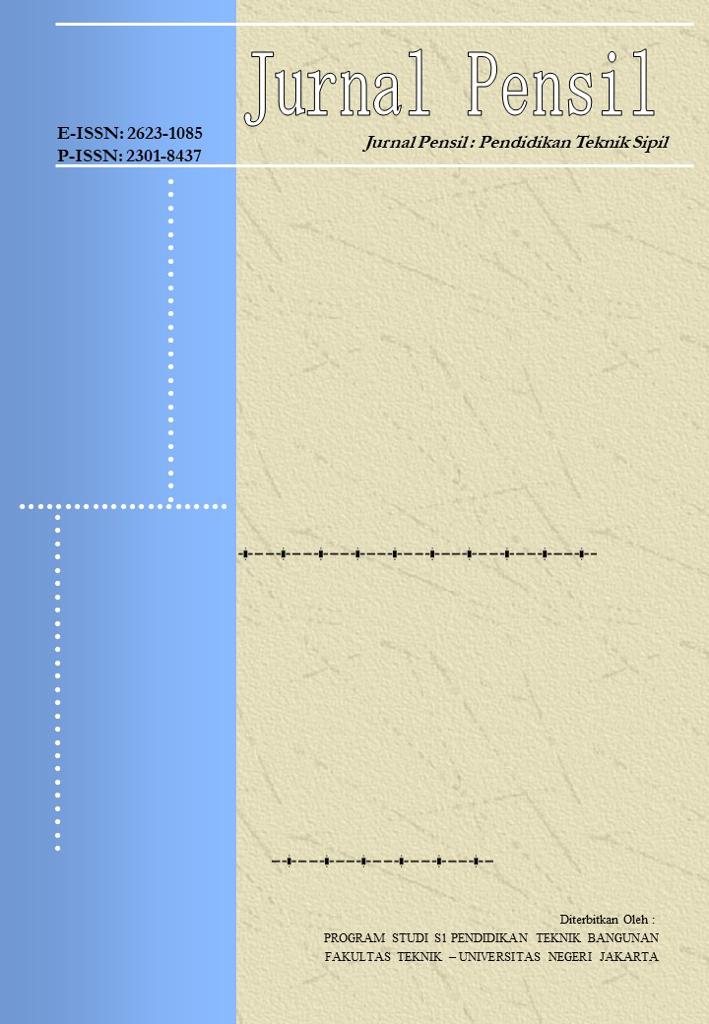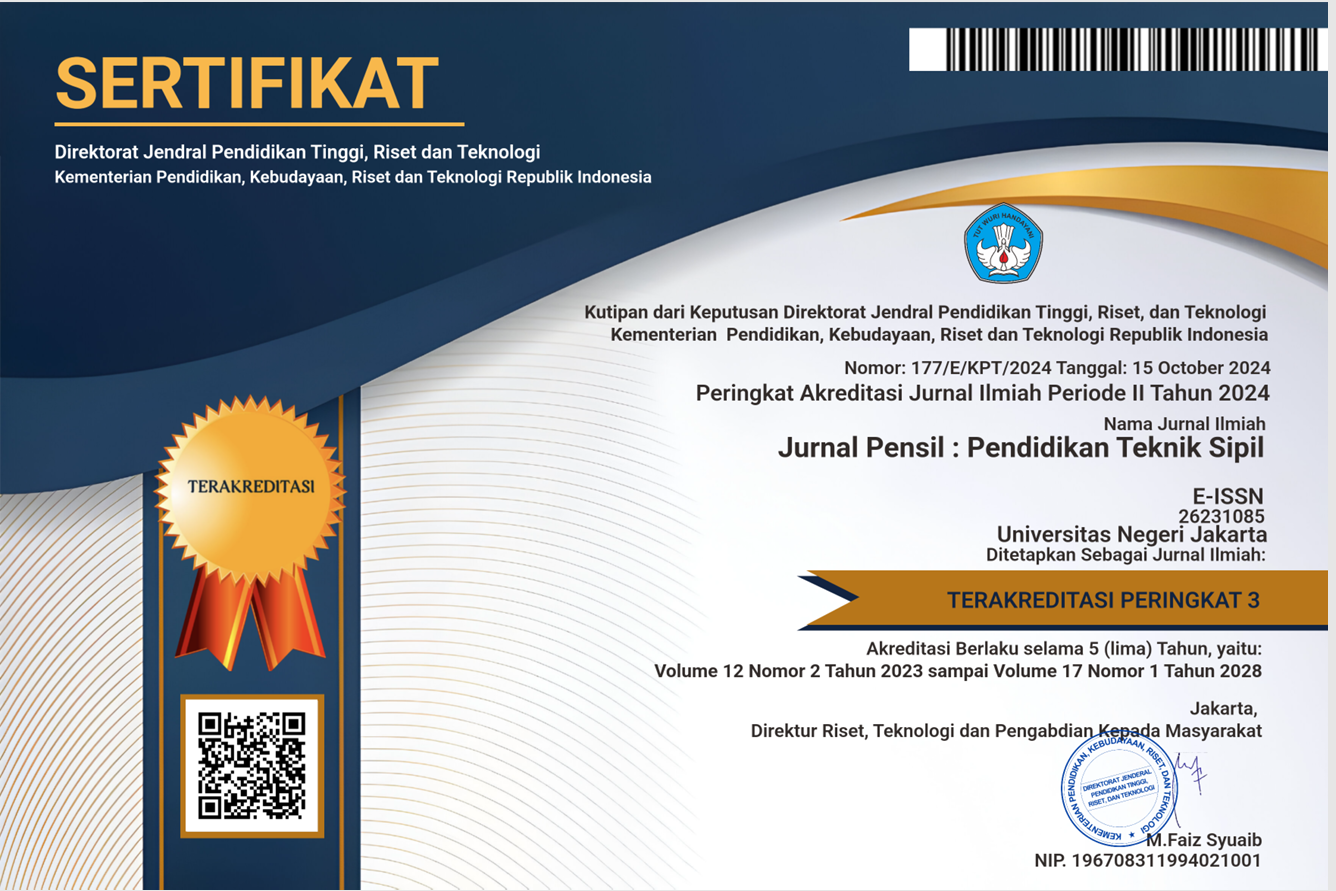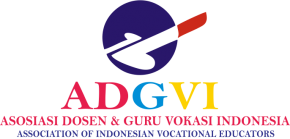RISK MANAGEMENT ANALYSIS IN SPALD-T PROJECTS
A CASE STUDY IN DKI JAKARTA
DOI:
https://doi.org/10.21009/jpensil.v14i1.47879Keywords:
SPALD-T, risk management, project performance, sanitation infrastructure, DKI JakartaAbstract
The Centralized Domestic Wastewater Management System (SPALD-T) projects play a crucial role in improving urban sanitation but face various risks that can affect project performance. This study aims to analyze the influence of risk factors on SPALD-T project performance in DKI Jakarta. Using a quantitative approach with a cross-sectional design, data were collected through a survey of 125 members of the SPALD-T project team. The questionnaire used has undergone validity and reliability tests to ensure accurate measurement of variables. Multiple regression analysis was employed to test the relationship between risk factors and project performance. The results indicate that waste management risk has a significant and positive influence on project performance, with a regression coefficient of 0.188 and a p-value of 0.001. Meanwhile, technical risk shows a positive trend but is not statistically significant, with a regression coefficient of 0.104 and a p-value of 0.078. These findings emphasize the importance of a comprehensive risk management approach, especially in waste management aspects, to improve SPALD-T project performance. This research contributes to the development of more effective risk mitigation strategies in the context of sanitation infrastructure projects in Indonesia and highlights the need for further research on the interaction between various types of risks in influencing project performance.
References
Agyekum, K., Adinyira, E., & Ampratwum, G. (2021). Factors limiting the adoption of sustainability practices in small and medium-sized construction firms. Journal of Engineering, Design and Technology, 19(2), 327-347. https://www.emerald.com/insight/content/doi/10.1108/JEDT-09-2019-0235/full/html
Asadi, P., Zeidi, J. R., Mojibi, T., Yazdani-Chamzini, A., & Tamošaitienė, J. (2021). Project risk evaluation by a new decision making model based on DE-COPRAS and CODAS methods. Economic Research-Ekonomska Istraživanja, 34(1), 1229-1253. https://www.tandfonline.com/doi/full/10.1080/1331677X.2020.1818595
Cahyono, B. E., Saptono, F., & Suharno, H. (2020). Risk management in water supply system project: A case study from Indonesia. Journal of Industrial Engineering and Management, 13(1), 135-154. http://jiem.org/index.php/jiem/article/view/3070
Darko, A., Chan, A. P., Ameyaw, E. E., Owusu, E. K., Pärn, E., & Edwards, D. J. (2018). Review of application of analytic hierarchy process (AHP) in construction. International journal of construction management, 18(4), 1295-1307. https://www.tandfonline.com/doi/full/10.1080/15623599.2018.1452098
Durdyev, S., Omarov, M., & Ismail, S. (2020). Causes of delay in residential construction projects in Cambodia. Cogent Engineering, 4(1), 1291117. https://www.tandfonline.com/doi/full/10.1080/23311916.2017.1291117
Ekanayake, E. M. A. C., Shen, G., Kumaraswamy, M. M., & Owusu, E. K. (2021). Identifying critical success factors for improving industrial solid waste management: case study of Sri Lanka. Journal of Cleaner Production, 312, 127767. https://www.sciencedirect.com/science/article/abs/pii/S0959652621019041
Farooq, M. U., Thaheem, M. J., & Arshad, H. (2018). Improving the risk quantification under behavioural tendencies: A tale of construction projects. International journal of project management, 36(3), 414-428. https://www.sciencedirect.com/science/article/abs/pii/S0263786317303113
Gunduz, M., & Elsherbeny, H. A. (2020). Critical Success Factors for Construction Projects: A Comprehensive Study. Engineering, Construction and Architectural Management, 27(5), 1027-1051. https://www.emerald.com/insight/content/doi/10.1108/ECAM-07-2019-0382/full/html
Iqbal, S., Choudhry, R. M., Holschemacher, K., Ali, A., & Tamošaitienė, J. (2015). Risk management in construction projects. Technological and Economic Development of Economy, 21(1), 65-78. https://journals.vgtu.lt/index.php/TEDE/article/view/566
Iqbal, S., Choudhry, R. M., Holschemacher, K., Ali, A., & Tamošaitienė, J. (2015). Risk management in construction projects. Technological and Economic Development of Economy, 21(1), 65-78. https://journals.vgtu.lt/index.php/TEDE/article/view/566
Keshk, A. M., Maarouf, I., & Annany, Y. (2018). Special studies in management of construction project risks, risk concept, plan building, risk quantitative and qualitative analysis, risk response strategies. Alexandria Engineering Journal, 57(4), 3179-3187. https://www.sciencedirect.com/science/article/pii/S1110016817302740
Koushki, P., AlSanad, S., & Kartam, N. (2021). Impact of safety procedures in the Kuwaiti construction industry. Safety Science, 139, 105248. https://www.sciencedirect.com/science/article/abs/pii/S0925753521000953
Kurniawan, F., Mudjanarko, S. W., & Ogunlana, S. (2021). Best practices for risk allocation in public-private partnership (PPP) contracts for toll road projects in Indonesia. Journal of Risk and Financial Management, 14(2), 80. https://www.mdpi.com/1911-8074/14/2/80
Lam, T. Y., Mahdjoubi, L., & Mason, J. (2019). A framework to assist in the analysis of risks and rewards in public private partnership in China. Journal of Management in Engineering, 35(1), 04018052. https://ascelibrary.org/doi/full/10.1061/%28ASCE%29ME.1943-5479.0000662
Liu, J., Zhao, X., & Yan, P. (2018). Risk paths in international construction projects: Case study from Chinese contractors. Journal of Construction Engineering and Management, 144(7), 04018071. https://ascelibrary.org/doi/full/10.1061/%28ASCE%29CO.1943-7862.0001506
Marques, R. C., & Berg, S. (2017). Risks, contracts, and private-sector participation in infrastructure. Journal of Construction Engineering and Management, 143(3), 04016089. https://ascelibrary.org/doi/full/10.1061/%28ASCE%29CO.1943-7862.0001262
Mohammadi, F., Sadi, M. K., Nateghi, F., Abdullah, A., & Skitmore, M. (2019). A hybrid quality function deployment and cybernetic analytic network process model for project manager selection for construction projects. Journal of Civil Engineering and Management, 25(2), 155-174. https://journals.vgtu.lt/index.php/JCEM/article/view/6866
Mojtahedi, M., & Oo, B. L. (2017). Critical attributes for proactive engagement of stakeholders in disaster risk management. International Journal of Disaster Risk Reduction, 21, 35-43. https://www.sciencedirect.com/science/article/abs/pii/S2212420916304721
Oyewobi, L. O., Windapo, A. O., & Rotimi, J. O. B. (2016). Relationship between decision-making style, competitive strategies and organisational performance among construction organisations. Journal of Engineering, Design and Technology, 14(4), 713-738. https://www.emerald.com/insight/content/doi/10.1108/JEDT-04-2015-0025/full/html
Patel, D. A., Kikani, K. D., & Jha, K. N. (2020). Hazard assessment using consistent fuzzy preference relations approach. Journal of Construction Engineering and Management, 146(5), 04020040. https://ascelibrary.org/doi/full/10.1061/%28ASCE%29CO.1943-7862.0001814
Rosenfeld, Y. (2014). Root-cause analysis of construction-cost overruns. Journal of Construction Engineering and Management, 140(1), 04013039. https://ascelibrary.org/doi/full/10.1061/%28ASCE%29CO.1943-7862.0000789
Sharma, S., & Gupta, Y. K. (2019). Predictive analysis and survey of COVID-19 using machine learning techniques. Journal of Interdisciplinary Mathematics, 22(3), 409-424. https://www.tandfonline.com/doi/full/10.1080/09720502.2019.1583450
Shen, W., Tang, W., Siripanan, A., Lei, Z., Duffield, C. F., Wilson, D., ... & Wei, Y. (2018). Critical success factors in Thailand's green building industry. Journal of Asian Architecture and Building Engineering, 17(2), 317-324. https://www.tandfonline.com/doi/full/10.3130/jaabe.17.317
Sinesilassie, E. G., Tabish, S. Z. S., & Jha, K. N. (2017). Critical factors affecting schedule performance: A case of Ethiopian public construction projects. Engineering, Construction and Architectural Management, 24(6), 1099-1120. https://www.emerald.com/insight/content/doi/10.1108/ECAM-03-2016-0062/full/html
Taber, K. S. (2018). The use of Cronbach's alpha when developing and reporting research instruments in science education. Research in Science Education, 48(6), 1273-1296. https://link.springer.com/article/10.1007/s11165-016-9602-2
Timbang, M. D., Nasir, A. R. M., Ramlee, N. F., & Nawi, M. N. M. (2021). Identifying critical success factors (CSFs) of disaster risk management (DRM) for the Malaysian construction industry. International Journal of Construction Management, 21(1), 55-66. https://www.tandfonline.com/doi/full/10.1080/15623599.2018.1506783
Timbang, M. D., Nasir, A. R. M., Ramlee, N. F., & Nawi, M. N. M. (2021). Identifying critical success factors (CSFs) of disaster risk management (DRM) for the Malaysian construction industry. International Journal of Construction Management, 21(1), 55-66. https://www.tandfonline.com/doi/full/10.1080/15623599.2018.1506783
Ullah, K., Abdullah, A. H., Nagapan, S., Sohu, S., & Khan, M. S. (2019). Measures to mitigate causative factors of budget overrun in Malaysian building projects. International Journal of Integrated Engineering, 11(1), 235-242. https://publisher.uthm.edu.my/ojs/index.php/ijie/article/view/2369
Ursachi, G., Horodnic, I. A., & Zait, A. (2015). How reliable are measurement scales? External factors with indirect influence on reliability estimators. Procedia Economics and Finance, 20, 679-686. https://www.sciencedirect.com/science/article/pii/S2212567115001239
Yusuf, G. A., Mohamed, S. F., Yusof, Z. M., & Misnan, M. S. (2020). Framework for enhancing cost management of building services. International Journal of Construction Management, 20(1), 29-38. https://www.tandfonline.com/doi/full/10.1080/15623599.2018.1484850
Zafar, I., Wuni, I. Y., Shen, G. Q., Ahmed, S., & Yousaf, T. (2019). A fuzzy synthetic evaluation analysis of time overrun risk factors in highway projects of Pakistan. Engineering, Construction and Architectural Management, 26(10), 2375-2405. https://www.emerald.com/insight/content/doi/10.1108/ECAM-11-2018-0532/full/html
Zaman, M. Q., Patel, D. A., & Bhatt, N. (2020). Integrated framework for risk assessment of expansion joints in concrete bridges. International Journal of Construction Management, 1-14. https://www.tandfonline.com/doi/full/10.1080/15623599.2020.1735514
Bonett, D. G., & Wright, T. A. (2015). Cronbach's alpha reliability: Interval estimation, hypothesis testing, and sample size planning. Journal of Organizational Behavior, 36(1), 3-15. https://onlinelibrary.wiley.com/doi/abs/10.1002/job.1960
Balatsky, A. V., Balatsky, G. I., & Borysov, S. S. (2020). Resource demand growth and sustainability due to increased world consumption. Sustainability, 12(3), 1266. https://www.mdpi.com/2071-1050/12/3/1266
Shrestha, N. (2021). Factor analysis as a tool for survey analysis. American Journal of Applied Mathematics and Statistics, 9(1), 4-11. http://article.sciencepublishinggroup.com/html/10.11648.j.ajams.20210901.12.html
Boateng, P., Chen, Z., & Ogunlana, S. O. (2015). An Analytical Network Process model for risks prioritisation in megaprojects. International Journal of Project Management, 33(8), 1795-1811. https://www.sciencedirect.com/science/article/abs/pii/S0263786315001039
Campos, L. C., Ross, P., Nasir, Z. A., Taylor, H., & Parkinson, J. (2020). Development and application of a methodology to assess sanitary risks in Maputo, Mozambique. Environment and Urbanization, 32(2), 481-500. https://journals.sagepub.com/doi/full/10.1177/0956247820924622
Chen, Z., Abdullah, A. B., Anumba, C. J., & Li, H. (2019). ANP experiment for demolition plan evaluation. Journal of Construction Engineering and Management, 140(2), 06013005. https://ascelibrary.org/doi/10.1061/%28ASCE%29CO.1943-7862.0000989
Doloi, H. (2018). Community-driven project management: Inter-stakeholder dynamics in infrastructure development. Construction Economics and Building, 18(4), 1-24. https://epress.lib.uts.edu.au/journals/index.php/AJCEB/article/view/6031
Gharaibeh, H. M. (2014). Cost control in mega projects using the Delphi method. Journal of Management in Engineering, 30(5), 04014024. https://ascelibrary.org/doi/10.1061/%28ASCE%29ME.1943-5479.0000218
Guo, F., Chang-Richards, Y., Wilkinson, S., & Li, T. C. (2014). Effects of project governance structures on the management of risks in major infrastructure projects: A comparative analysis. International Journal of Project Management, 32(5), 815-826. https://www.sciencedirect.com/science/article/abs/pii/S0263786313001555
Hillson, D., & Simon, P. (2006). Practical Project Risk Management: The ATOM Methodology. Management Concepts Press.
Hwang, B. G., Zhao, X., & Toh, L. P. (2014). Risk management in small construction projects in Singapore: Status, barriers and impact. International Journal of Project Management, 32(1), 116-124. https://www.sciencedirect.com/science/article/pii/S0263786313000252
Kang, Y., O'Brien, W. J., Thomas, S., & Chapman, R. E. (2015). Impact of information technologies on performance: cross study comparison. Journal of Construction Engineering and Management, 141(10), 04015045. https://ascelibrary.org/doi/10.1061/%28ASCE%29CO.1943-7862.0001006
Lekatompessy, R. F., Saputri, D. A., & Sulastri, M. (2022). Perencanaan Sistem Pengolahan Air Limbah Domestik Terpusat di Kelurahan Duri Utara, Jakarta Barat. Jurnal Teknologi Lingkungan, 23(1), 1-10. https://journals.itb.ac.id/index.php/jtl/article/view/15456
Liang, X., & Jia, H. (2018). Investigating the influential factors of stakeholders' satisfaction in nuclear power projects: Empirical study based on structural equation model. Sustainability, 10(7), 2234. https://www.mdpi.com/2071-1050/10/7/2234
Liu, J., Gong, E., Wang, D., & Lai, X. (2019). Innovative sustainability assessment framework for wastewater treatment plants. Journal of Cleaner Production, 238, 117907. https://www.sciencedirect.com/science/article/abs/pii/S0959652619326344
Liu, J., Zhao, X., & Yan, P. (2018). Risk paths in international construction projects: Case study from Chinese contractors. Journal of Construction Engineering and Management, 144(2), 05017019. https://ascelibrary.org/doi/10.1061/%28ASCE%29CO.1943-7862.0001422
Nguyen, P. T., Likhitruangsilp, V., & Onishi, M. (2020). Success factors for public-private partnership infrastructure projects in Vietnam. International Journal on Advanced Science, Engineering and Information Technology, 10(2), 858-865. http://ijaseit.insightsociety.org/index.php?option=com_content&view=article&id=9&Itemid=1&article_id=10572
Ogunsanmi, O. E. (2016). Risk classification model for design and build projects. Journal of Engineering, Project, and Production Management, 6(2), 90-108. https://www.ppml.url.tw/EPPM_Journal/volumns/06_02_July_2016/ID_133_6_2_90_108.pdf
Padilla-Rivera, A., Morgan-Sagastume, J. M., Noyola, A., & Güereca, L. P. (2016). Addressing social aspects associated with wastewater treatment facilities. Environmental Impact Assessment Review, 57, 101-113. https://doi.org/10.1016/j.eiar.2016.02.005
Qazi, A., Quigley, J., Dickson, A., & Kirytopoulos, K. (2016). Project Complexity and Risk Management (ProCRiM): Towards modelling project complexity driven risk paths in construction projects. International Journal of Project Management, 34(7), 1183-1198. https://www.sciencedirect.com/science/article/abs/pii/S0263786316300679
Renuka, S. M., Umarani, C., & Kamal, S. (2014). A review on critical risk factors in the life cycle of construction projects. Journal of Civil Engineering Research, 4(2A), 31-36. http://article.sapub.org/10.5923.c.jce.201401.07.html
Safapour, E., Kermanshachi, S., & Taneja, P. (2019). A review of nontraditional project delivery methods for transportation projects: Identifying the factors affecting implementation. Journal of Management in Engineering, 35(4), 04019002. https://ascelibrary.org/doi/10.1061/%28ASCE%29ME.1943-5479.0000695
Suprayogi, M. I., Nindito, H., & Winahyu, D. (2017). Risk management in new student admission system. IOP Conference Series: Materials Science and Engineering, 185(1), 012038. https://iopscience.iop.org/article/10.1088/1757-899X/185/1/012038
Szymanski, P. (2017). Risk management in construction projects. Procedia Engineering, 208, 174-182. https://www.sciencedirect.com/science/article/pii/S1877705817360293
Tscheikner-Gratl, F., Egger, P., Rauch, W., & Kleidorfer, M. (2019). Comparison of multi-criteria decision support methods for integrated rehabilitation planning of urban water infrastructure. Water, 11(2), 258. https://doi.org/10.3390/w11020258
Ugarelli, R., Venkatesh, G., Brattebø, H., & Saegrov, S. (2010). Asset management for urban wastewater systems: Challenges and risks. Water Science and Technology, 62(7), 1654-1663. https://doi.org/10.2166/wst.2010.716
Wang, N., Xia, L., Niu, M., Hua, C., Jiang, X., & Ping, F. (2020). Research on the critical factors in the whole process of PPP project: Taking municipal sewage treatment project in China as an example. Environmental Science and Pollution Research, 27(26), 32389-32405. https://link.springer.com/article/10.1007/s11356-020-09383-y
Zhang, X., & Fan, Y. (2014). Project risk management in urban infrastructure projects. International Journal of Project Management, 32(4), 495-505. https://doi.org/10.1016/j.ijproman.2013.12.005
Downloads
Published
How to Cite
Issue
Section
License
Copyright (c) 2025 Nining Ardiyanti Hasan

This work is licensed under a Creative Commons Attribution-ShareAlike 4.0 International License.











.png)
.png)
1.png)

